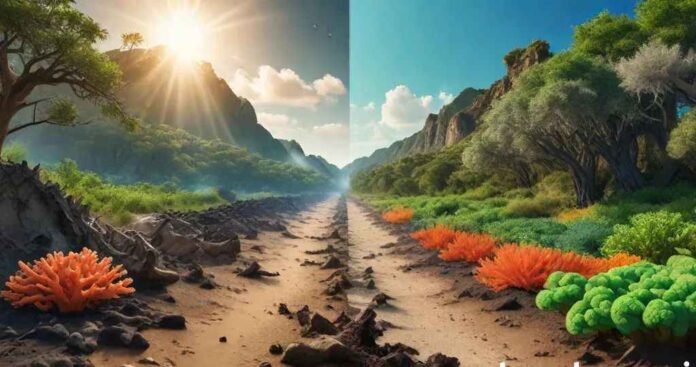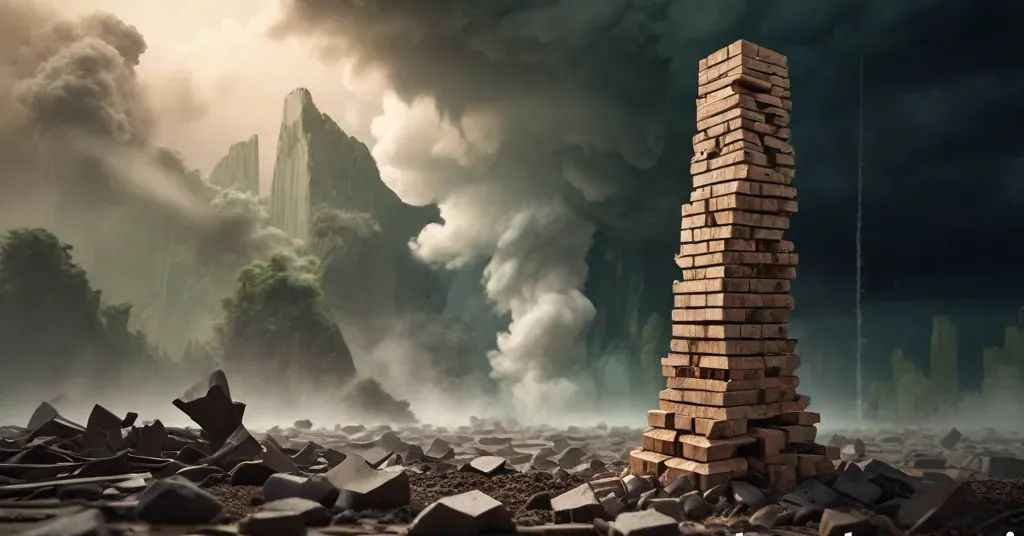
Imagine a world with silent forests, bleached coral reefs, and increasingly extreme weather. This isn’t a scene from a movie; it’s a potential future shaped by the broken relationship between climate change and biodiversity. While often treated as separate issues, they are two sides of the same coin. The health of our planet depends on understanding this critical connection.
In this article, we’ll cut through the complexity to explore how climate change is devastating wildlife, why protecting nature is our most powerful weapon against a warming planet, and the global efforts underway to fix this dual crisis.
Table of Contents
The Stark Reality: Nature in Crisis
Let’s be clear about the scale of the problem. The IPBES Global Assessment Report starkly concludes that around 1 million species already face extinction, many within decades, due to human activities. Adding to this, the WWF’s Living Planet Report 2022 documented a 69% average decline in the sizes of monitored mammal, bird, amphibian, reptile, and fish populations since 1970.
What does this have to do with climate? Everything. Climate change is accelerating from a contributing threat to a primary driver of this loss. The Intergovernmental Panel on Climate Change (IPCC) warns that with global temperatures already 1.1°C above pre-industrial levels, we are seeing unprecedented impacts. Their data suggests that if warming reaches 1.5°C to 2.5°C, we risk losing 20-30% of all assessed species. The link is undeniable and accelerating.
How Climate Change is Shattering the Web of Life
Climate change doesn’t just create a warmer world; it creates a disjointed and unstable one for the species that call it home. The impacts are profound and measurable:
- Habitat Loss and Fragmentation: The NASA Earth Observatory reports that we are losing 18.7 million acres of forests annually, equivalent to 27 soccer fields every minute, much of it driven by climate-aggravated fires and droughts. Rising seas, which have increased by about 8-9 inches (21-24 cm) since 1880 (NASA), are eroding coastal habitats.
- The Great Migration: A 2017 study in Science Advances found that marine species are moving towards the poles at an average rate of 59 kilometers per decade, while land species are moving 17 kilometers per decade, disrupting ecosystems.
- Ocean Acidification and Coral Bleaching: The ocean has absorbed about 30% of the emitted anthropogenic CO2, leading to a 26% increase in ocean acidity since the industrial revolution (IPCC). This, combined with warmer waters, caused the Global Coral Reef Monitoring Network to report the loss of 14% of the world’s coral reefs between 2009 and 2018.
Tipping Points and Unexpected Consequences
The damage isn’t always slow and linear. Climate change and biodiversity loss can combine to push ecosystems past “tipping points”—irreversible thresholds that trigger a cascade of dramatic changes. Think of it not as a gradual decline, but like a Jenga tower; remove one too many key blocks, and the entire structure collapses unexpectedly.

Here are some of the most critical and surprising domino effects:
The Albedo Effect and the Arctic: The loss of bright, reflective sea ice (biodiversity loss at a microbial and algal level) leads to the exposure of dark ocean water, which absorbs more heat. This “albedo effect” is a primary reason the Arctic is warming up to four times faster than the global average, which in turn disrupts global weather patterns, leading to extreme cold spells in temperate regions and altered monsoon seasons.
The Amazon’s Flips from Carbon Sink to Carbon Source: The Amazon rainforest has long been the planet’s “lungs,” absorbing billions of tons of CO2. However, a 2021 study in Nature found that due to deforestation, warming, and fires, parts of the eastern Amazon have now flipped to emitting more carbon than they absorb. This turns a vital climate solution into a major climate driver, accelerating global warming in a dangerous feedback loop.
The “Zombie Forest” Phenomenon: In the American West, researchers have identified millions of acres of “Zombie Forests” or “Ghost Forests.” These are trees that are still standing but are already dead or doomed because the climate has shifted around them. They are no longer suited to the warmer, drier conditions and will not be able to regrow after fires or disease, fundamentally changing the landscape.
Disease Spillover and Pandemics: Biodiversity loss directly increases human health risks. A diverse ecosystem acts as a “dilution effect,” where viruses are spread among many animal species. When we lose biodiversity, viruses circulate among fewer, more dominant species (often rodents or bats) that live closer to humans. A 2020 study in Proceedings of the Royal Society B linked habitat destruction with an increased risk of diseases like COVID-19, Ebola, and Nipah virus spilling over into human populations.
The Surprising Flip Side: Biodiversity is a Climate Solution
Here’s the hopeful part we often miss: just as climate change harms biodiversity, a rich and diverse natural world is one of our most powerful allies in the fight against climate change.
Ecosystems like forests, peatlands, and oceans are natural carbon sinks, meaning they absorb and store vast amounts of carbon dioxide from the atmosphere.
- Forests: Protecting and restoring forests offers roughly two-thirds of the total potential of all natural climate solutions.
- Peatlands: These wetlands (like marshes and swamps) cover only 3% of the world’s land but store twice as much carbon as all the forests combined.
- Mangroves and Seagrasses: These coastal powerhouses can sequester carbon at rates up to four times higher than terrestrial forests.
In fact, improving nature’s ability to absorb emissions could provide about one-third of the greenhouse gas reductions we need in the next decade. Protecting nature is not just conservation; it’s smart climate policy.
To truly grasp the interconnected crisis, it helps to visualize this destructive cycle and its potential solution. The following table breaks down the two-way relationship between climate change and biodiversity:
The Climate-Biodiversity Feedback Loop
| How Climate Change Harms Biodiversity | How Biodiversity Helps Fight Climate Change |
|---|---|
| ➜ Habitat Loss & Fragmentation: Rising seas and desertification destroy living spaces. | ➜ Natural Carbon Sequestration: Forests, peatlands, and mangroves absorb and store vast amounts of CO₂. |
| ➜ Species Extinction: Warming temperatures and acidifying oceans push species beyond their limits. | ➜ Ecosystem Resilience: Diverse ecosystems are better able to withstand and recover from climate impacts. |
| ➜ Ecosystem Collapse: Events like coral bleaching transform vibrant habitats into dead zones. | ➜ Climate Regulation: Healthy ecosystems maintain local and global weather patterns and temperatures. |
| The Result: A weaker, less diverse natural world that is more vulnerable to change. | The Result: A stronger, more resilient planet that can absorb our emissions and stabilize the climate. |
As the table shows, this is a feedback loop. The path we are on—letting climate change degrade nature—is a vicious cycle that weakens our planet’s life-support systems. However, by flipping the script and protecting biodiversity, we can create a virtuous cycle that builds a more stable and resilient world for all.
A Glimmer of Hope: Global Action and the Role of Indigenous Stewards
Recognizing this interconnected crisis, the world is finally starting to act. The Kunming-Montreal Global Biodiversity Framework is a historic UN agreement, much like the Paris Agreement for climate, specifically designed to halt and reverse biodiversity loss.
A key outcome is the launch of the Cali Fund, aimed at mobilizing $200 billion annually by 2030 to close the biodiversity funding gap. As the UN Secretary-General stated, “Those profiting from nature cannot treat it like a free, infinite resource. They must step up.”
Crucially, these agreements recognize that Indigenous Peoples are the guardians of our nature. Their traditional knowledge and sustainable practices are a living library of biodiversity conservation. Protecting their rights is essential to protecting our planet.
What Can We Do? Our Collective Responsibility
The solution requires all of us:
- As Citizens: We can support policies that protect natural areas and transition to renewable energy.
- As Consumers: We can make sustainable choices, reduce waste, and support companies committed to ethical practices.
- As Communicators: Raising awareness about this interconnected crisis is the first step toward collective action.
Our Choice: A Vicious Cycle or a Virtuous One
The data leaves no room for doubt. We are at a crossroads, facing a fundamental choice between two futures.
One path leads to a vicious cycle: climate change degrades ecosystems, which then lose their ability to regulate the climate, leading to more severe change and further biodiversity collapse.
The other path leads to a virtuous cycle: by investing in nature—protecting forests, restoring wetlands, and supporting Indigenous stewardship—we build a resilient world that can absorb carbon, stabilize our climate, and provide for all life.
The unbreakable bond between climate and biodiversity is not a trap; it is the key. By healing one, we heal the other. The future of our planet’s vast, intricate web of life—and our own place within it—depends on the choice we make today.
The time to act is now.
Read Also: The Impact of Climate Change on Biodiversity: Challenges and Solutions



